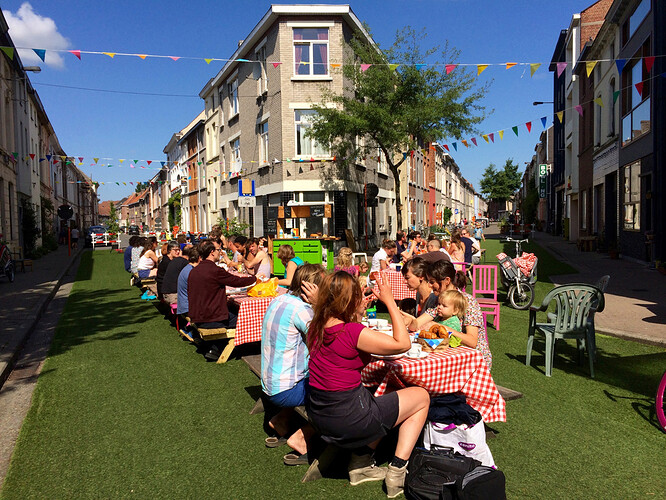“Local authorities are no longer perceived as the only party expected to solve complex issues in cities” (source)
This post follows a conversation between Pieter Deschamps (www.labvantroje.be/en) and @Noemi and aims to provide ideas about effective urban mobilization and partnership building between cities and citizens.
Living Streets is a project in Ghent, Belgium, where neighbors collaborate to temporarily redesign their streets for a couple of months, when neighborhood parking areas are marked down away from the street. You would see safe playgrounds built, or new green meeting spaces, or social, communal activities. A flagship project of the Trojan Lab non-profit, it went on for 4 years now, involving more than 25 streets, but as an experiment, it also had an expiration date: the end of 2017. An experiment as it was, its eyes were always on the prize: exploring a new approach of public space, finding alternatives for street parking and reworking people’s relationship with city officials.
The story begins with the city administration itself: in 2011 it was part of a European program about the transition to a climate neutral city. The result was that we should rethink the mobility system in order to become climate neutral. Beginning of 2012, the city of Ghent started a transition arena. Pieter was one of the 20 people involved in this arena, as he used to work for the National Railway Company and involved in sustainable mobility development. These 20 people were brought together, and had the opportunity to be critical on the current system but also had the power of imagining a future vision, how it could be better.
In this process, after six months, the arena developed a transition agenda for sustainable mobility in Ghent, where a couple of critical choices were identified, that needed to be made to achieve that vision. “Hard choices” they called them: two of them were the basis for the Living Street project. So:
- The arena had the vision
2) They determined some critical hard choices, policy making decisions
3) At that point the arena had developed about 10 ideas for how this can be put in practice. Living Streets was one of these ideas.
Pieter: “After 6 months we pitched these ideas and while the city’s work was done at the time, we didn’t feel we were done. I will always remember that night. These 20 people sat in a bar and said “how can we make our ideas real”. That’s how it all started.”
The group didn’t have a status at the time, they weren’t the government neither a NGO. It was just a group of people that went on and organized in 2013 the first Living Streets in 2 streets. The city of Ghent helped by giving the permission to experiment with a new kind of street.
Pieter: “We evaluated it with the city administration and wanted to carry on. We needed a legal status for two reasons: first, to be legally covered when things go wrong, and be able to protect ourselves and the project. A second is that we were starting to work with money, we had private sponsors and companies saying they were interested in what we are trying to discover. We organized an NGO, very close to the city organisation, because we wanted to change the system.”
The mission of that NGO (The Trojan Lab) was - within the timeframe of 5 years, and importantly, in between 2 elections - organizing as many as possible experiments and gather lessons, see what dynamics all this can start. We’ll stop before the elections to make sure that every political group has the possibility to take the lessons and translate them into the government system.
Where the project is today
The Living Street experiment has 3 strategic goals:
- How can we evolve from street park to neighborhood parking?
2) How can we turn grey streets to more lively/colorful streets?
3) If we create spaces on street level where people can meet each other and come together in a peaceful way, will this strengthen social cohesion in the neighborhood?
Evaluation was in-built, it had to do with the process of arriving at a Living Street.
Pieter: “We started engaging people with the question “What if?”; mapping the ideas and also the interests of people. “How do I look at my neighborhood?” from the perspective of social security, traffic, safety, more green in the streets,… For each remark we mobilize our network and creativity to support initiators from each street to find solutions. After that process is done, the people come up with a vision for their living street, that will be implemented in practice. Evaluation is an ongoing process, so things can be changed during it.”
The project is driven by the communities in the city. The Trojan Lab started the mapping and year after year new people were interested to help and lead the process, or involve others. The quality check was always done by the organization.
Pieter: “In terms of social cohesion, it’s crystal clear after 51 Living Street-processes in Ghent, we created a new space at street level that improves relations between residents, between the city government and his residents and we discovered innovative solutions to redesign the street and park the car at a neighborhood parking.
What next?
The Trojan Lab and the volunteers from the Living streets are now helping the local government to think about and rethink how Living Streets would look like without the role of the Trojan Lab. What’s in it for the city administration: it involves bringing different public stakeholders together with those who have participated from the streets, to think how it can continue in the upcoming years. Are you also dreaming of a living street? Share your stories with the pioneers of Ghent.
Website: www.livingstreet.eu
